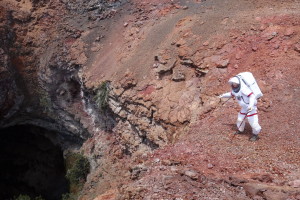When we finally get to Mars, where will we live?
That seems like a pretty obvious question. We’ve all seen the movies, read the books. In the future, we live where I live now: in white domes on the surface of forbidding planets, in full view of local and cosmic radiation, fully exposed to the whims of weather systems, struggling to maintain internal comfort and safety in the face of shifting temperature extremes only a few inches outside the fragile walls….
…Yep. Living in white domes on the surface of other planets is a lot like standing in front of those booths at the state fairs where everything – Mars bars, Coca-cola, ding-dongs – is dipped in batter and fried. The longer you think about it, the worse an idea it seems.
Fortunately, the surface of a planet is only one of many possible places where one can live in space. By volume, there is much, MUCH more space below the surface of a planet. When it comes to living on Mars – or, in this case, IN Mars – we have a bit of a leg up. Our nearest potentially-habitable neighbor shares an important geologic feature with Earth. It’s one that we have no end of here on sMars, and could make all the difference when we decide to try living on another planet: volc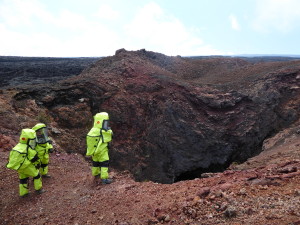 anism.
anism.
For sure, you don’t want to roll up on an active volcano and start digging. Or, in this case, spelunking. Dormant volcanoes, on the other hand, are a great place to live. Lava loves to travel long distances if it can. As terrifying as a lava flow covering the surface can be, that’s not how lava prefers to travel. If it can, lava travels by tube.
Beneath the Earth, lava tubes carve out cave-like systems that go on for many, many miles. Very near the surface, they can be thin and brittle. A few meters below the surface, they can seem to stretch on without end. In the vicinity of our dome alone, there are dozens of such open-ended tube networks.
Since Mauna Loa is still an active volcano – in fact, it’s more active now than it has been in recent years – setting up shop in these lava tubes is not the way to go. Nothing ruins a dinner party like several metric tons of rapidly flowing, semi-liquid rock. Mars, though, hasn’t been geologically active for eons. If Mars has lava tubes, those may be our best bet for safely setting up shop.
It seems ironic that we would travel 200 million miles just to become cave dwellers again. But, when you think about it, o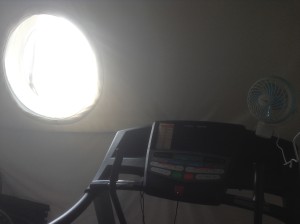 ur forebears were in those caves for a very good reason. Caves are weather-resistant. They maintain their internal temperatures far better than almost any surface dwelling. Their thick walls provide pre-built radiation shielding. What they don’t have, and what human beings need more than we understand, is light.
ur forebears were in those caves for a very good reason. Caves are weather-resistant. They maintain their internal temperatures far better than almost any surface dwelling. Their thick walls provide pre-built radiation shielding. What they don’t have, and what human beings need more than we understand, is light.
To a certain extent, and for a limited time, we can live without light. Then, very bad things start to happen. The first thing that’s usually affected, though it’s sometimes subtle, is the sleep/wake cycle. Then, mood. Finally, physical well-being.
This can take a while to set in. For our two weeks in HERA, we had no windows at all. We accepted this in part because the duration of sun-deprivation was short. Also, everything on our screens told us that we were in the vacuum of space. The sun was at our backs during our “trip” out to the asteroid.While flying through space, no direct sunlight is somewhat acceptable (it might even be preferable).
While on a planetary body for months at a time…that may well be a different story. In our hab on sMars, the two small portholes are pretty much our favorite spots, followed by the the airlock and the teleporter room, which are bright in the morning and afternoon, respectively. Almost instinctively, we pull folding chairs into these areas to soak up the sun-tinged space. We don’t have to. We have personal solar lights, as well as a large tanning light that’s part of a study. On top of that, we EVA several times a week.
Even so, with all that technology and face-time with the Sun while on EVA, we are drawn to the light. More than that, we are drawn to the VIEW. On cloudy days, like today, when the clouds cling to the mountainside like a blanket, it’s harder to find comfort in the view. The world, which was only 1700 square feet to begin with, feels much, much smaller.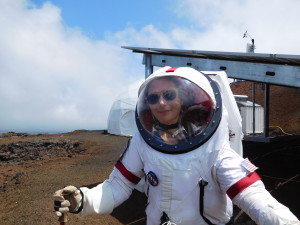
The more you think about it, the more you realize that designing these space-cave-habitats will be a truly artistic act of engineering. Humans, accustomed to free reign over the Earth, having just tolerated months of confinement in a tin can, will then inflate an underground dwelling in order to survive. As willing as we are to do this intellectually, our brains and our bodies are going to want what they want: to to live as they have before, with abundant movement and a ready source of light.
So what can we, the once and future cave dwellers, do to bring sunlight into our distant lava tubes? Our space architect, Tristan Bassingthwaighte, had a neat idea: use fiber optic cables to channel light down from the surface. Add in video screens with live feeds for a more surround-view effect.
Would something like that be enough? Or will we want to see, with our own eyes, the surface of the world we’ve come so far to live upon? Will we even have a choice when we get there?
At first, I don’t see how we will. It’s short, rather risky stays on the surface, or underground for the long haul. I know which one I would choose. I also know that I look out that window every single day, at least a dozen times, and that doing so makes me feel, well, human.
This has been the case as long as I can remember. When I was young, I would sneak upstairs at midnight and gaze out our living room windows onto the San Fernando Valley below. When I left home at 15, I lived with a family in Mexico that had a green mango tree large enough to swallow the world. In high school, I had a view of the elm-and-astor-filled front drive of my back east boarding school. At Berkeley, my apartment looked out onto three bridges: the Richmond, th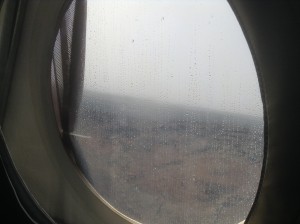 e Bay, and the Golden Gate. In graduate school, I slept in the library of an old house and awoke every morning to the sight of the morning sun on the Ladd Observatory, just across the street. In medical school, my studio apartment looked out on the ocean, across two peninsulas and a dozen boats anchored in True Blue Bay, which, true to its name, was eternally sky blue by day, and a deep luminous blue laced with glowing algae by night.
e Bay, and the Golden Gate. In graduate school, I slept in the library of an old house and awoke every morning to the sight of the morning sun on the Ladd Observatory, just across the street. In medical school, my studio apartment looked out on the ocean, across two peninsulas and a dozen boats anchored in True Blue Bay, which, true to its name, was eternally sky blue by day, and a deep luminous blue laced with glowing algae by night.
Today, the view out the window was a few feet of red lava rock and fog. Tomorrow, it may be more of the same. Or, it may be a clear day, revealing red, grey and brown rubble of frozen rock stretching as far as the eye can see. But at least my eye CAN see it. That feels important somehow. Well-arranged pixels may be enough to take the edge off. The occasional EVA will allow me to get my vitamin D on. I’m not sure that I can get that feeling of expansive freedom, of really living on the surface of this strange world, from staring at a screen. I’m not sure how at home I’ll feel on Mars, or anywhere, if I don’t have at least one window to the world.
In fact, I was pretty convinced that I couldn’t feel at home on Mars without a window, until I looked over my shoulder, and saw this sitting on my desk.
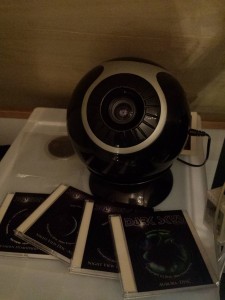 For a kid from LA, who has lived in big cities most of her life, it is totally acc
For a kid from LA, who has lived in big cities most of her life, it is totally acc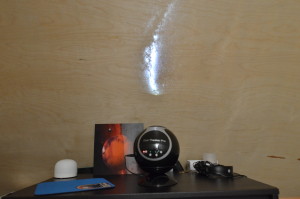 eptable for the spiral arm of the galaxy to live in a 6-inch-diameter black-and-silver ball. To be able to conjure it, along with the aurora, the constellations, and the view of the Earth from space with the flick of a switch is perfectly normal, if not entirely natural.
eptable for the spiral arm of the galaxy to live in a 6-inch-diameter black-and-silver ball. To be able to conjure it, along with the aurora, the constellations, and the view of the Earth from space with the flick of a switch is perfectly normal, if not entirely natural.
As strange as it may seem, because of where I grew up and how I have lived, this is almost as real to me as lying out under the stars on top of a mountain or out in the desert.
Almost.
If this little device is enough to bring a sky full of stars (almost) into my 8 foot by 3 foot bunk on simulated Mars, maybe there is the right sort of technology – or the right sort of human – such that the windows to the world can be projections, real-time or pre-programmed, and still give the viewer some sense of freedom.

